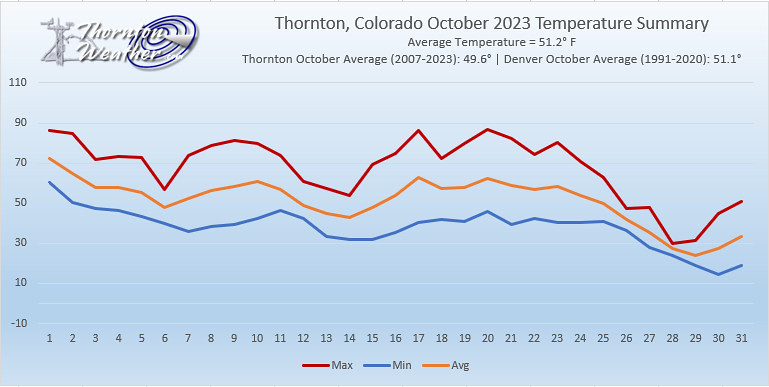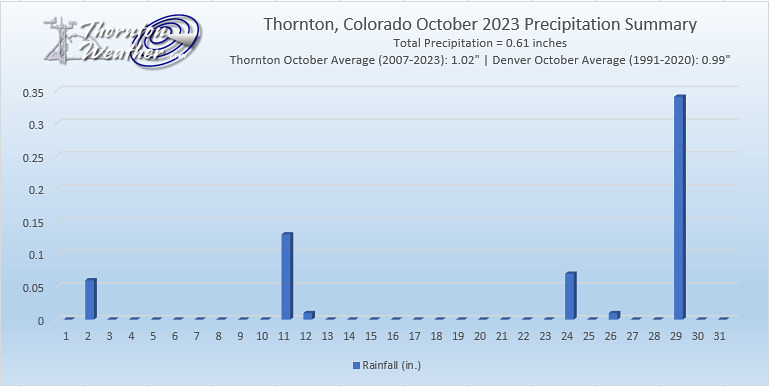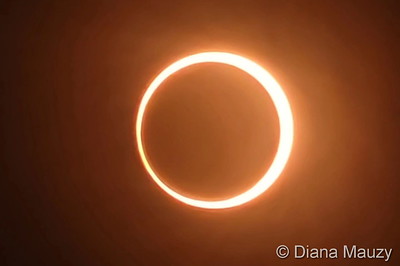
Temperatures continue to cool as we get further into fall and our look back at this week in Denver weather history provides some insight into the types of extreme weather that are possible this time of year. Noteworthy events include many incidences of damaging wind and some monstrous snowstorms.
From the National Weather Service:
18-23
In 2003…an extended warm spell resulted in 5 new temperature records. The high temperature of 84 degrees on the 18th equaled the record high for the date. High temperatures of 86 degrees on the 19th…83 degrees on the 21st…and 84 degrees on the 22nd were record highs for the dates. Low temperature of 49 degrees on the 23rd was a record high minimum for the date. Low temperatures during the period were in the 40’s and lower 50’s.
19-20
In 1990…an early winter storm dumped heavy snow across metro Denver. Snowfall amounts ranged from 4 to 8 inches in the foothills above 6500 feet elevation…4 to 7 inches in the Castle Rock area…and 2 to 5 inches across most of metro Denver and Boulder. Snowfall totaled 3.6 inches at Stapleton International Airport where northwest winds gusting to 48 mph kicked up some blowing dust shortly after a cold frontal passage on the 19th. However… Temperatures were warm enough to keep most roadways wet and slushy at lower elevations.
19-23
In 1906…heavy snowfall totaled 22.7 inches in the city over the 5 days. Rain changed to snow on the evening of the 19th…and snow continued through the late afternoon of the 23rd. The heaviest amount of snowfall…16.0 inches…fell from 8:00 pm on the 20th to 8:00 pm on the 22nd. The most snow on the ground was 13.3 inches on the evening of the 23rd. This was the first snow of the season and the only snow of the month. Winds during the storm were from the north at sustained speeds of 20 to 30 mph each day. Temperatures during the storm were generally in the 20’s.
20
In 1878…between 3:00 pm and 4:00 pm wind speeds averaged 48 mph with a maximum 1 minute sustained velocity to 96 mph at both 3:27 pm and 3:48 pm in downtown Denver. This is the highest sustained wind speed ever recorded in the city.
In 1986…a rare late October thunderstorm produced 3/4 inch diameter hail at Centennial Airport. Hail piled up 2 1/2 inches deep…causing some street flooding in south metro Denver.
In 2019…strong bora winds swept across the foothills and adjacent plains. Peak gusts included: 82 mph…3 miles southwest of Rocky Flats; 78 mph near White Ranch Open Space; 75 mph near Genesee and Georgetown; with 63 mph at Firestone. At Denver International Airport…a peak gust of 49 mph was observed from the west.
20-21
In 2007…a storm system brought heavy snow to the southern Denver suburbs as well as the Palmer Divide south of Denver. Storm totals included: 7.5 inches near Castle Rock…Lone Tree and Greenwood Village…with 6.5 inches at Elizabeth. Snow drifts up to 2 feet deep were observed 6 miles south-southwest of Elizabeth. In the Denver Stapleton area…2.0 inches of snow was observed.
In 2009…heavy snow developed along the Palmer Divide south and southeast of Denver as a storm system tracked across southern Colorado and northern New Mexico. Storm totals included: 15 inches…15 miles north of Elizabeth…9 inches…5 miles south-southwest of Arapahoe Park; 8 inches in Highlands Ranch…5 miles south- southeast of Sedalia; 6.5 inches…8 miles southwest of Bennett and 6 inches in Parker. At Denver international… Only 1.5 inches of snowfall was observed.
20-22
In 1936…5.5 inches of snow fell over downtown Denver. Most of the snow…4.5 inches…fell on the 20th.
21
In 1920…the rare event of snow from a thunderstorm occurred in the city during the evening. Brilliant flashes of lightning and loud peals of thunder were first noted at 7:35 pm. Light rain began falling at 8:30 pm…and light moist snow began falling a few minutes later. Some soft hail was also seen falling with the rain and snow…but both melted almost as fast as they fell. The hail only continued for a few minutes…and the rain and snow ceased about 9:40 pm. The snowfall was the first to occur in Denver this season. The amount of precipitation at the station measured only 0.01 inch…but heavier amounts were reported from other parts of the city. Snowfall was only a trace.
21-22
In 1978…heavy rain on the 21st changed to snow by daybreak on the 22nd and continued the rest of the day. This was the first measurable snowfall of the season…but totaled only 1.7 inches at Stapleton International Airport where east winds gusted to 29 mph. While only a trace of snow covered the ground…precipitation totaled 1.27 inches.
22
In 1878…winds were sustained to 42 mph.
In 1887…the first measurable snow of the season occurred… Ending the longest snow-free period in Denver…232 days… Since the last snow on March 5th.
In 1947…the first snow of the season totaled only 1.6 inches. Post-frontal north winds caused temperatures to plunge from a high of 60 degrees at midnight to a low of only 30 degrees 24 hours later. This was the only snow of the month.
In 1985…high winds gusting from 60 to 80 mph buffeted the Front Range foothills. The strongest reported wind gust was 89 mph in eastern Boulder. A treehouse east of Boulder was set on fire by a downed power line. Two people in Boulder were injured. A woman broke her arm when the strong winds knocked her to the ground. A carpenter in the city suffered a severely cut hand while he was trying to repair a roof that was being torn from a building. At Stapleton International Airport…northwest winds gusted to 41 mph.
In 2001…west-northwest winds gusting as high as 54 mph warmed the temperature to a high of 70 degrees at Denver International Airport.
22-23
In 1914…post-frontal rain changed to snow. Precipitation totaled 2.72 inches…most of which was in the form of moist snow which melted as it fell in the business section of the city. About 3 inches of snow was measured on lawns in the residential areas on the morning of the 24th. Official snowfall totaled only 0.4 inch downtown… But an estimated 8.0 inches of snow melted as it fell. North to northeast winds were sustained to 29 mph with gusts to 30 mph on both days.
In 1975…a vigorous cold front moving across metro Denver followed by strong northeast winds gusting to 52 mph produced billows of blowing dust and plunged the temperature 21 degrees in an hour. The surface visibility was reduced to 1/4 mile in blowing dust at Stapleton International Airport. The temperature cooled from a daily record high of 81 degrees to a low of 38 degrees by day’s end. The first snowfall of the season totaled 2.7 inches on the 23rd. This was the only measurable snow of the month at Stapleton International Airport.
In 1995…heavy snow fell on the Palmer Ridge south of Denver and in the foothills west of Denver where snow amounts ranged from 4 to 8 inches. Sedalia…south of Denver… Received 8 inches of snow. Winds strengthened on the plains and produced blizzard conditions…reducing surface visibilities to less than 1/4 mile. I-70 was closed from just east of Denver at Gun Club Road to the Kansas border. Ten inches of snow fell at Strasburg east of Denver where north winds at sustained speeds of 35 to 45 mph with gusts as high as 60 mph produced 2 to 4 foot drifts. Snowfall totaled only 2.2 inches at the site of the former Stapleton International Airport. North winds gusted to 51 mph at Denver International Airport.
Continue reading October 20 to October 26: This Week in Denver Weather History →



























































 With the first full month of fall here, October usually brings one of the quietest weather months in the Denver area with plenty of mild, sunny days and clear, cool nights.
With the first full month of fall here, October usually brings one of the quietest weather months in the Denver area with plenty of mild, sunny days and clear, cool nights.


